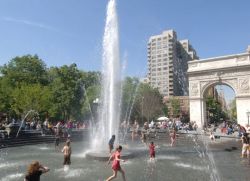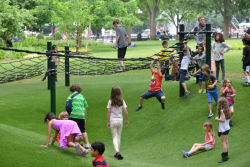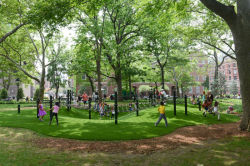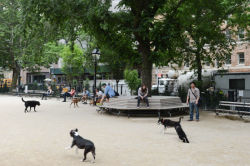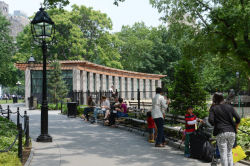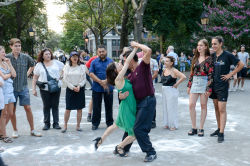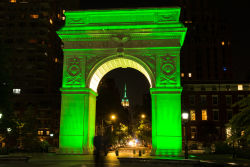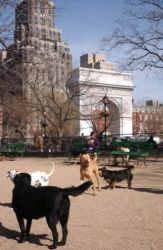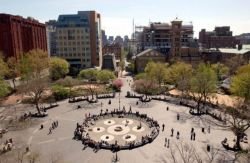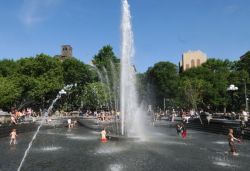Washington Square Park
Washington Square Park
Washington Square Park is named for George Washington (1732-1799), the commander of the Continental Army, who was inaugurated in New York City as the first President of the United States on April 30, 1789.
The land was once a marsh fed by Minetta Brook located near an Indian village known as Sapokanikan. In 1797 the City’s Common Council acquired the land for use as a "Potter's Field” and for public executions, giving rise to the legend of the "Hangman’s Elm" in the park's northwest corner.
Used first as the Washington Military Parade Ground in 1826, the site became a public park in 1827. Following this designation, prominent families, wanting to escape the disease and congestion of downtown Manhattan, moved into the area and built the distinguished Greek Revival mansions that still line the square’s north side. In 1838 the park hosted the first public demonstration of the telegraph by Samuel F.B. Morse.
Soon after the creation of the City’s Department of Public Parks in 1870, the square was redesigned and improved by M.A. Kellogg, Engineer-in-Chief, and I.A. Pilat, Chief Landscape Gardener. Their plan followed the principles of Fredrick Law Olmsted – providing a more rustic and informal space with curvilinear paths along its periphery, retaining many of the diagonal paths within the park’s core, and defining plots of grass with shade trees. The most dramatic change was the addition of a carriage drive through the park's interior connecting Fifth Avenue to Lower Manhattan.
The marble Washington Arch, designed by noted architect Stanford White, was built between 1890-1892 and replaced a wooden arch erected in 1889 to honor the centennial of the first president’s inauguration. Statues of Washington were later installed on Arch's north side – Washington as Commander-in-Chief, Accompanied by Fame and Valor (1916) by Hermon MacNeil, and Washington as President, Accompanied by Wisdom and Justice (1918) by Alexander Stirling Calder.
Other monuments in this park are John Quincy Adams Ward’s bust of steel innovator Alexander Lyman Holley (1890), Giovanni Turini’s statue of Italian-nationalist leader Giuseppe Garibaldi (1888), a World War I commemorative flagpole, and the central fountain which was moved from Fifth Avenue and 59th Street in the mid-1870s.
Washington Square Park was redefined socially and culturally throughout the 20th century. Following the Triangle Shirtwaist Factory fire in 1911, labor unions marched here. "Ashcan School" artists such as John Sloan painted in the park, and the bohemian community of the late 19th and early-20th centuries congregated here. The Beat generation of the 1940s and 50s and the "folkies" of the late 1950s and early 60s also made the park their sanctuary. During this period the park became a renowned haven for performers and protestors.
Through these social upheavals, Fifth Avenue ran through the Arch until 1964 when the park was redesigned and closed to traffic at the insistence of vigilant Greenwich Village residents. The late 1960s and early 1970s saw the lowering of the fountain and creation of a two-tiered central plaza which cemented its reputation as an ad hoc performance space. A new mounded area to the southwest became a cherished play space and chess and gaming tables at the south and northwest entryways created a vibrant culture with an international reputation.
In the 1990s both playgrounds were upgraded, petanque courts built at a "teen plaza" in the southeast park precinct, and a dog run was introduced. In 2003-04 the Washington Square Arch was restored. After an intensive analysis of the park's historical development and a process of community input unprecedented in scope the park was rebuilt in a three-phase renovation designed by landscape architect George Vellonakis. The first phase (2009) included a renovated and accessible fountain and plaza, conservation of the Alexander Holley Monument, additional seating, expanded lawns, and new planting beds that increased the park's green space.
The second phase (2012) provided a small dog run, a new chess plaza, a performance stage, renovated petanque courts, as well as enhanced landscaping, lighting and pathways, and the relocation and conservation of the statue of Garibaldi. The third and final phase, completed in 2014, features BKSK Architects' new LEED-certified park house and public restroom, whose subtle curvature, reclaimed wood, stone palette and low profile integrate with the lush surroundings. To the southwest, the asphalt mounds were replaced by a new mounded play area submerged in a meadow and made safer and more attractive with artificial turf.
Today Washington Square Park, rich in history, remains one of the jewels in the park system, serving as a dynamic commons for local residents, chess players, students, performers and tourists from around the globe.
Check out your park's Vital Signs
Clean & Safe
Green & Resilient
Empowered & Engaged Users
Share your feedback or learn more about how this park is part of a
Vital Park System

